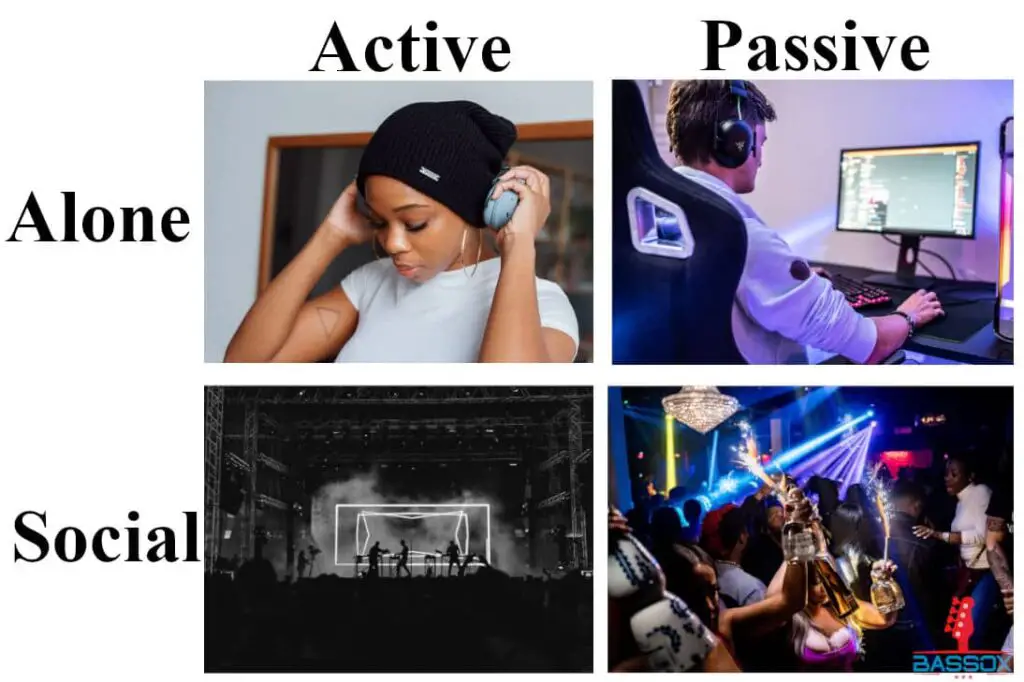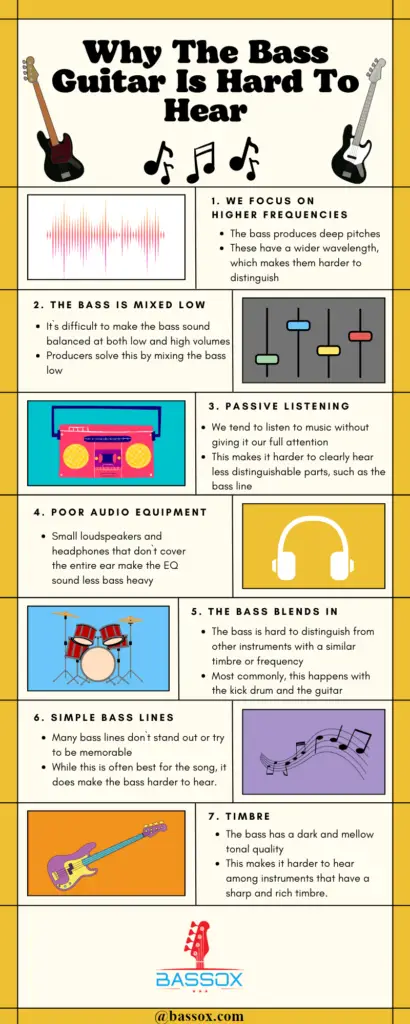If you are struggling to hear the bass in songs, you are not alone. This is often the first thing people say when I tell them I play the bass, and to be honest, I even struggle to hear the bass myself at times.
More importantly, there are several reasons why you might find it difficult to hear the bass that have little to do with the quality of your hearing. In fact, most of it simply comes down to how our ears work, as well as how songs are commonly written, produced, and listened to.
So, don`t think there is anything wrong with your ears if you find it difficult to hear the bass in songs. Instead, check out these 7 reasons why you, me, and many others often struggle to hear it.
Alternatively, if you are strictly looking for ways to notice the bass better, check out these 9 tips for hearing the bass in songs.
1. Our ears focus on higher frequencies
At deeper pitches, musical notes have a long wavelength. On the other hand, higher pitches have a shorter wavelength.
In the graph below, the highest frequency is represented by the pink wave. This wave repeats its pattern approximately 13 times.
The deepest frequency is represented by the red wave. In the same amount of time the pink wave repeats its pattern 13 times, the red wave only repeats its pattern 3 and a half times.

Thus, we get almost 4 times as many chances to take in the full information of the pink wave. Because the full information of the soundwave is presented to us more times at higher frequencies, these pitches also sound clearer to us.
This is the reason why we perceive higher-frequency notes more clearly, and lower-frequency notes less clearly.
The range of the bass guitar is deep, and bassists often stick to its lowermost register. Thus, it is often hard to hear the bass when it is played with other more high-pitched instruments.
Not only that, but the wavelength of notes played on instruments at different registers can differ immensely. In fact, for every octave we go up in pitch, the wavelength of a note is halved.
| Musical Note | Frequency | Wavelength |
| C1 | 32.7 Hz | 1055 Cm |
| C2 | 65.4 Hz | 527 Cm |
| C3 | 130.8 Hz | 264 Cm |
| C4 | 261.6 Hz | 132 Cm |
| C5 | 523.3 Hz | 66 Cm |
| C6 | 1046.5 Hz | 33 Cm |
Other instruments regularly play 2-4 octaves above the bass guitar. Thus, it is no wonder that it can be hard to hear the bass, as the wavelengths other instruments produce are then 4-16 times as easily perceivable to our ears.
2. The bass is mixed too low
While the bass can differ greatly in volume between genres, it is common for it to be mixed relatively low.
One reason for this is due to the psychoacoustic effect. In short, this effect is why our ears perceive sounds with the same intensity but different timbres, as having different volumes.
For example, a kick drum and a bass guitar could be set to the exact same volume, but we could still perceive one to be louder than the other.
Furthermore, this difference in perceived intensity varies at different volumes. You might have noticed this at some point when trying to hear the bass, as it is harder to hear at lower volumes, but sounds louder in the mix at higher volumes.
When it comes to mixing songs, producers are thus limited in how much emphasis they can put on making the bass audible. Oftentimes, this results in producers erring on the safer side and mixing the bass relatively low.
While not ideal, this is often considered preferable to risking the bass ruining the whole mix.
This is simply due to how our ears work, and there is not much we can do about it. Though, I find that it helps to understand how the psychoacoustic impacts bass volume, rather than blame my ears for being bad or producers for not knowing what they are doing.
3. Passive Listening
Where and how you listen to music affects how you perceive a song.
This is best described in Dr. Dan Mamlok’s 2017 paper, where he makes a clear distinction between “listening” and “hearing”.
“Listening” here refers to actively listening to music. This means noticing the different elements of the song and how they work together. “Hearing” is a more passive form of listening, where we notice and enjoy the song, but are not actively paying attention to it.
We can also listen to music alone and in social settings both passively and actively:

More often than not, people listen to music in a passive way, or simply “hear” it as Mamlok would put it.
Examples of this include putting on music while driving, walking, exercising, reading, or gaming. It also includes hearing music at social gatherings or parties.
Personally, I am not taking a stance on how you should or shouldn`t listen to music. However, when it comes to noticing the bass in songs, it is harder to do so while passively listening to music.
This makes sense, as we have learned that it is the higher frequencies that are the easiest to pick out in a mix. On the other hand, the deep frequencies of the bass often need to be listened for instead.
Furthermore, the bass line tends to become easier to pick out when you notice what the drums and guitars are playing. Thus, as you actively listen to a song, more and more parts of it will start to make sense and the bass will thus also appear more audible.
4. Poor Audio Equipment
As stated in this 2019 study from ICCAIS, small loudspeakers result in a poor low-frequency response. Small loudspeakers are here referring to the type of speakers that are built into phones or headphones.
This means that it is harder for the loudspeaker to accurately reproduce the low end of a song or recording. As the bass is a low-frequency instrument, it can thus be harder to hear on phone speakers and poor-quality headphones.
Personally, I find that my phone speaker has way too much treble regardless of how I EQ it. I do not consider them to be built for listening to music, and hearing the bass is extremely difficult with them.
However, my small mid-range earbuds have sufficient bass for me not to consider it an issue. I much prefer listening on a proper set of headphones for better sound quality, but the lack of bass in decent earbuds has not been detrimental to me.
If you are using headphones or earbuds, whether they cover your entire ear also makes a big difference. This is because when there is room for sound waves to escape the enclosure, the lower frequencies will be the first ones to do so.
While not as important as covering the entire ear, active noise canceling is also helpful for better noticing the bass. This is because outside interferences are generally higher pitched than the bass. This results in more layers that we have to distinguish and shift out in order to hear the bass properly.
5. It blends in with the other instruments
Sometimes, we can hear the bass but just don`t know it ourselves. This happens when the bass is audible to us but is difficult to distinguish from the other instruments in a song. In my experience, there are 2 main cases where this tends to happen:
The bass blends in with the kick drum
It is very common for the bass drum and bass guitar to blend together in a mix. This happens both because the two instruments are played at a similar frequency range and fill a similar musical role.
Thus, despite the bass and drums being vastly different instruments, the kick drum can distort what the bass sounds like in the mix, and vice versa.
The kick and the bass can blend together due to poor mixing and EQ and a failure to separate the two. On the other hand, they can also intentionally be mixed to fill out one another and function as 1 instrument that is greater than the sum of its parts.
Thus, this blending together can both elevate or ruin a song. Regardless of whether it is done well or poorly though, it does make it harder to hear the bass guitar.
The bass blends in with the guitars
In some genres, the bass can also blend together with the guitars.
Generally, this happens because the two instruments are using similar effects. This in turn makes their timbre sound similar, which can make them sound more like one instrument.
This is a big reason that hearing the bass in metal is difficult, as it is common for both guitarists and bassists to use distortion. Due to the use of distortion and overdrive, the same thing also happens in rock and punk, albeit less commonly.
In modern forms of metal, it is common for the bass to play simple lines that are intended to create a wall of sound with the guitars. In this case, it is often a sign that the song is well mixed when the bass and guitars are hard to distinguish.
6. Bass lines don`t stand out
More often than not, bassists tend to play simple bass lines that are not intended to sound catchy or unique.
For example, here is a simple bass line that you will commonly find in genres like rock and pop:

The function of a bass line like this is to fill in the low end and make the mix sound whole, rather than being attention-grabbing. As a result, it does its job well, but people pay less attention to bass lines of this kind.
Playing less noticeable parts is not unique to bass players. Keyboard players often add layers and pads that are often hard to pick out in a mix. Similarly, some guitar parts can also sound anonymous in a mix, especially so when there are two guitar players.
Yet, we don`t think of the keyboard or the guitar as instruments that are hard to hear in the same vein as the bass. This comes at least partly from the fact that the keys and guitars are intermittently noticeable whereas the bass often is not.
Another part of this is that simple bass lines are easy to point out as hard to hear. It is harder to say that we don`t hear the rhythm guitarist when we hear one guitar, or that we don`t hear the keys when we weren`t even aware that they were playing anything.
7. Timbre
Timbre refers to what type of tone an instrument produces. For example, an E2 played on the bass and the piano has the same frequency and pitch, but a different timbre and tone.
When different instruments are played at the same time, their timbre has a big impact on which of them we first pay attention to. Generally, rich and sharp timbres tend to cut through in a song, whereas mellow and dark timbres tend to be harder to hear.
As you might have guessed, the bass guitar and double bass both have timbres of the latter kind. Thus, in addition to their lower pitch, the tonal quality of the bass also makes it harder to hear.
This has to do with how the instruments are built, but also how they are played.
A 2010 study from the University of Delaware looked at how the double bass could produce different timbres when played in different ways. For example, it was found that bowing results in a warm timbre with a lot of expression. Plucking the strings with the fingers instead results in a more staccato tone that can be used for a rounder and duller tone.
Similarly, how a bass guitar is played has a big effect on its timbre. Plucking a bass with the fingers results in a warm tone that is generally poor at cutting through the mix. On the other hand, slapping it with the thumb results in a percussive and sharp timbre that can more easily be heard among other instruments.
However, as the bass is played with the fingers more often than slapped, it also usually produces a timbre that is difficult to hear among other instruments.
Conclusion
As you can tell by now, there are multiple reasons why the bass guitar is so hard to hear in songs.
First and foremost, the pitch and the timbre of the instrument make it difficult for our ears to pick out the bass in a mix. To make matters worse, the bass is often mixed low due to how the psychoacoustic affects how we perceive the bass as different volumes.
Also, if we use poor audio equipment and listen to music passively, the bass becomes significantly harder to hear. Bass lines are also often simple and can blend with the kick drum or guitars, which makes them harder to distinguish in the mix.
To keep track of all of this, I`m leaving you with an infographic that summarizes the information in this article. Save, print, link, bookmark, pin it, or do whatever else you think will be helpful.


